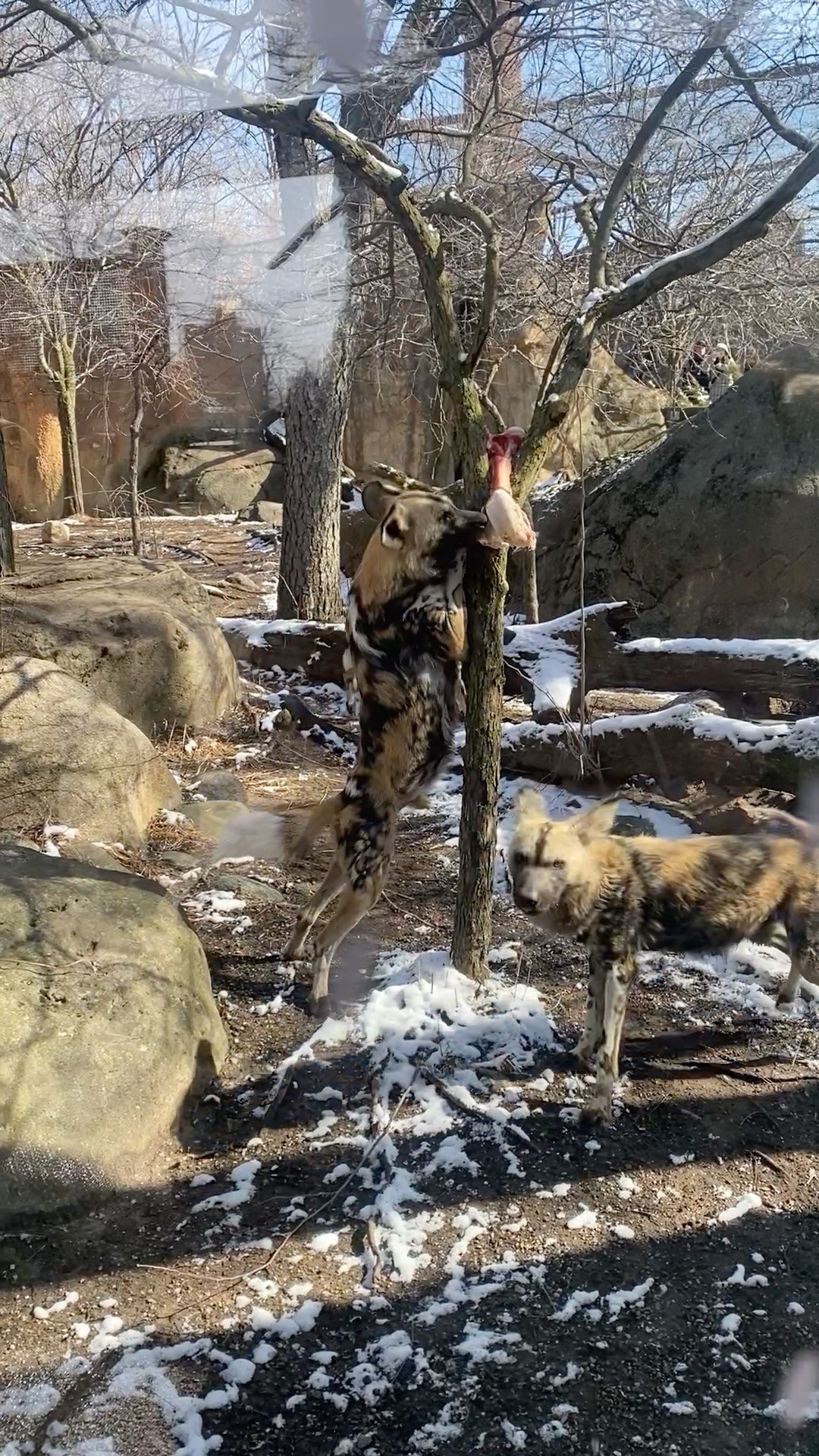– African painted dogs and their cooperative hunting strategies
– The role of environmental enrichment in captive animal behavior
– African painted dogs in wildlife conservation and their role in the ecosystem
– Challenges faced by African-painted dogs in the wild and captivity
– Educational and conservationist perspectives on zoo management
—
In Africa’s vast savannas, woodlands, and shrublands, a remarkable species known as the African-painted dogs thrive through cunning and teamwork. Frida, Vincent, and Dante are members of this extraordinary species, distinguished by their mottled coats, large rounded ears, and structured social hierarchy that defines their existence in the wild and managed environments such as zoos.
An intriguing scene unfolds at their habitat within a zoological park where a savory snack—meat—is suspended high in a tree. This strategic placement of food is not merely to feed them; it serves a greater purpose—to stimulate their intellect and fortify their innate hunting abilities. African-painted dogs are notorious for their hunting prowess, often operating as a cohesive unit to take down prey, a skill crucial for survival.
Environmental enrichment, providing stimulating and challenging environments and scenarios for captive animals, is essential for maintaining species like African-painted dogs’ physical and mental well-being. The intentional placement of food in hard-to-reach spots encourages problem-solving and mimics the challenges these canids would face in the wild. Such exercises imbue captive animals with a sense of purpose and can help alleviate the monotony often associated with captivity.
Zoos employing such enriching techniques play a pivotal role in wildlife conservation, offering a sanctuary for endangered species and fostering research that can aid in their preservation. Captive breeding programs have become a lifeline for many species, and educational initiatives can inspire public support for conservation efforts.
In the wild, African-painted dogs, also known as Lycaon pictus, embody the essence of communal living. Their social structures are complex, with a strict dominance hierarchy led by an alpha pair. These dogs communicate through various vocalizations, body language, and touch, enabling them to execute coordinated attacks with remarkable precision.
This strategy has made them one of Africa’s most efficient predators, with success rates in their hunts being exceptionally high compared to other large carnivores on the continent. Working collaboratively, they outmaneuver even the most agile antelopes. Yet, despite their effectiveness as hunters, African-painted dogs face considerable challenges in the wild. Their populations have been greatly impacted by habitat fragmentation, human-wildlife conflict, and diseases such as rabies and canine distemper.
In captive settings, zoo management teams such as the one caring for Frida, Vincent, and Dante prioritize these animals’ health and well-being. By providing large, complex enclosures and replicating the dogs’ natural social structures, zoos can foster a semblance of the wild for these adaptive creatures. African-painted dogs within zoos have another critical function: education. Visitors observing the dynamics of the pack can gain valuable insights into the species’ behaviors and the intricate balance of ecosystems, hopefully spurring an appreciation that translates into support for conservation actions.
Yet, not all is ideal in the lives of captive African-painted dogs. Despite the best efforts of conservationists and zookeepers, captivity can never fully recreate the vast landscapes and freedom these canids experience in the wild. Behavioral issues can arise, and the constant challenge for zoos is balancing the needs of the animals with logistical constraints and public safety requirements.
As zoos continue to evolve as centers for conservation and education, the plight of the African-painted dogs is a testament to the ongoing struggle many species face in a changing world. Wildlife conservationists tirelessly protect these dogs by establishing protected areas, anti-poaching units, and community-based conservation projects that engage local people as stakeholders in preserving wildlife.
When institutions like zoos present African-painted dogs in their care, they do not merely display an exotic species—they open a window into the complex interplay of biodiversity and the urgent need for human stewardship. Stories like those of Frida, Vincent, and Dante highlight the delicate dance of conservation, where every action can ripple outwards with implications for entire species.
These efforts resonate with the broader mission of safeguarding our planet’s biodiversity and ensuring that future generations can witness the majesty of African-painted dogs and other emblematic species in their natural state. Watching this pack tackle the challenge set before them, their shared determination reveals not only the resilience of their kind but also the dedication of those working behind the scenes to preserve the intricate tapestry of life on Earth.
*****
Source Description
African-painted dogs Frida, Vincent, and Dante go after a savory snack. Hanging the meat higher in the tree encourages these pack hunters to work together to figure out how to get it down. Thanks to their pack mentality regarding the hunt, African-painted dogs are among Africa’s most effective predators!
This clip was snapped earlier in the year, but keepers routinely place meat throughout their habitat to encourage the pack’s sharp minds and hone their excellent hunting techniques.
📸 Ariana Ewing


